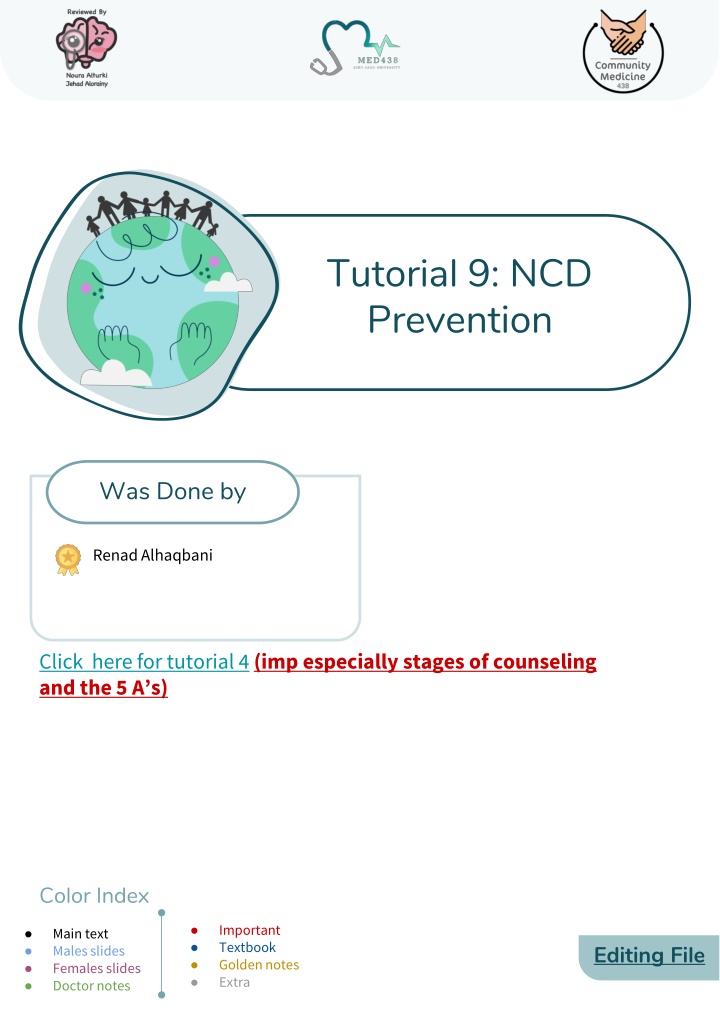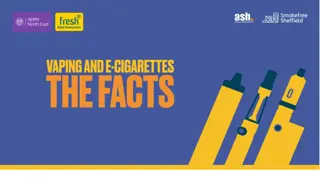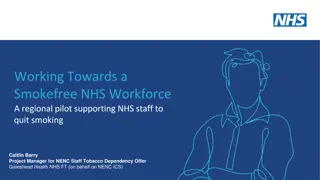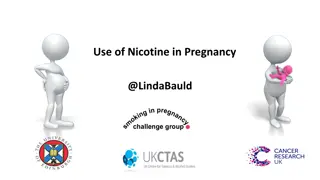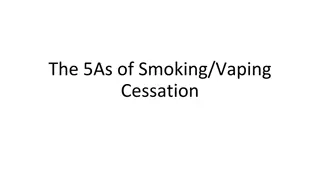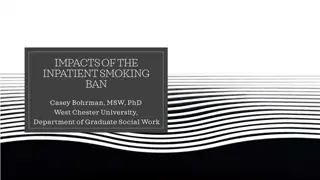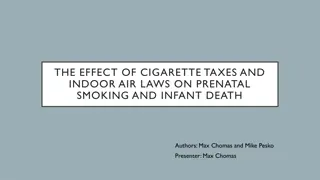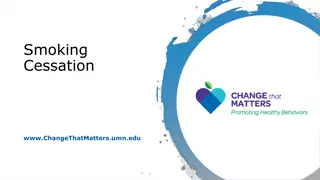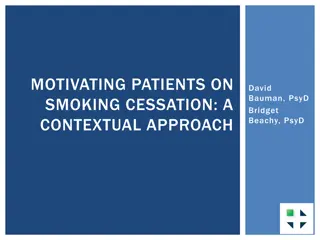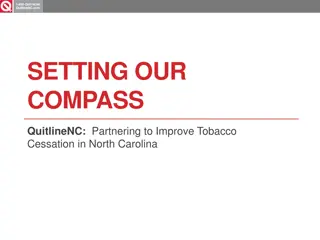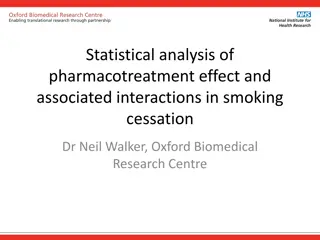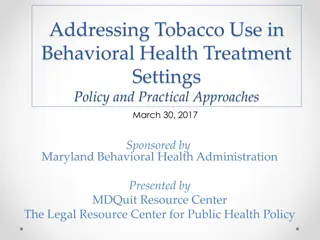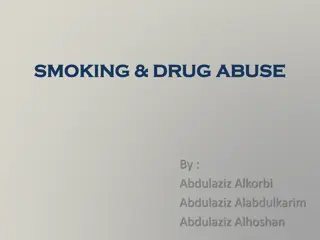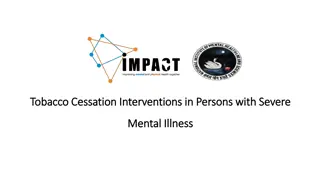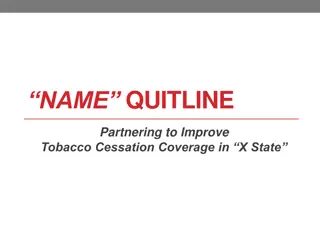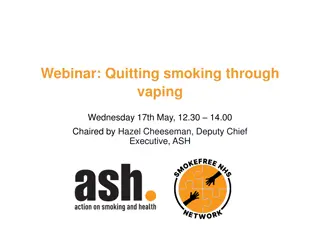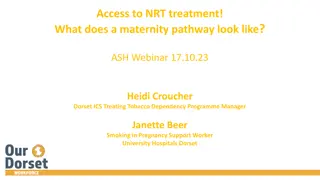Smoking Cessation Counseling for a 44-Year-Old Man
Abdullah, a 44-year-old man, seeks help to quit smoking. This tutorial covers the counseling approach for smoking cessation, including history-taking, discussing smoking habits, addressing concerns like fear of lung cancer, and incorporating the 5 A's approach: Ask, Advise, Assess, Assist, and Arrange. Practical tips such as behavioral counseling, pharmacological treatment options, setting a quit date, and follow-up plans are provided to assist Abdullah in his journey to quit smoking successfully.
Download Presentation

Please find below an Image/Link to download the presentation.
The content on the website is provided AS IS for your information and personal use only. It may not be sold, licensed, or shared on other websites without obtaining consent from the author.If you encounter any issues during the download, it is possible that the publisher has removed the file from their server.
You are allowed to download the files provided on this website for personal or commercial use, subject to the condition that they are used lawfully. All files are the property of their respective owners.
The content on the website is provided AS IS for your information and personal use only. It may not be sold, licensed, or shared on other websites without obtaining consent from the author.
E N D
Presentation Transcript
Tutorial 9: NCD Prevention Was Done by Renad Alhaqbani Click here for tutorial 4 (imp especially stages of counseling and the 5 A s) Color Index Important Textbook Golden notes Extra Main text Males slides Females slides Doctor notes Editing File
Abdullah a 44-year-old man came to you for help as he is thinking to quit smoking. His BMI 27 and his BP 136/ 84 Cass 1 Take a history and how are you going to counsel him to quit smoking? What areas are you going to discuss regarding smoking history? smokers around him at home or work? 2 4 1 3 5 History of previous attempts of quitting: How many times? Success or failure and why? Smoking history: how many? how long? General health issues: Chronic disease: CVD, HTN, chronic cough, depression, etc. Explores ICE : (Have to be asked in history taking) Idea: He wants to give up, will some medication help him , or there are other options to try Concern: Mostly he is afraid to have lung cancer Expecting: to get a advise on how to stop smoking Chance for opportunistic screening (only asked e.g. BP) Motivation to quit is he ready to quit smoking? Important for OSCE Family history:CVD, Stroke, Cancer, etc. Recall from Tutorial 4 The 5 A s: Ask, Advise, Assess, Assist, and Arrange. ASK:Ensure that tobacco-use status is obtained and recorded at every patient visit, and ask an open-ended question Have you ever smoked? How often do you smoke? When is the last time you smoked? How many cigarettes did you smoke yesterday/last week/last month? Why do you think it would be a good idea to quit? Do you dip or use snuff? ADVICE: Advise your patients to quit smoking. Use clear, strong, and personalized language to get your point across. Quitting is the single most important thing you can do to protect your health as well as your family. quitting will help you to save money. ASSESS: Ask every patient if she is willing to quit at this time. If she is willing to quit, offer praise and provide resources and assistance. If they have tried to quit in the past, get more information. So you ve tried to quit. What do you think triggered you to start smoking again? If unwilling to quit, help motivate the patient by using the 5 R s : Relevance, Risks, Rewards, Roadblocks, and Repetition. ASSIST: Assist your patients with a quit plan. ARRANGE: Schedule follow-up visits/phone calls to review patient progress toward quitting. Important steps in all cases: 1) full history 2) focus history 3) maintain eye contact 4) break bad news by asking: what're your expectations?
How can you help him to quit smoking? Discuss the benefits to quit smoking Discuss the risks associated with smoking (cancer, COPD, ect) Behavioral smoking counseling(Avoid places used for smoking, tell family and friends about quitting smoking, firm refusal of cigarette from others). Discuss the different pharmacological treatments options and their efficacy. Brief him about choices of Nicotine replacement therapy or varenicline (Champix) Agree on a plan to proceed with his quitting Define a date to stop smoking(e.g. write a contract between physician and smoker, put this contract in a place to be seen daily, remove ash tray, through any cigarette at home, anything reminding for smoking) Respect his choiceof advice on who to approach Encourage him to attend the Primary care smoking cessation clinic. Agree on discussing his success or failure attempts after two weeks
Extra Practice with Checklist of smoking cessation From 436 OSCE file
Mona a 46-year-old woman came to check some results. She is totally asymptomatic. BMI 31, BP 124/75 Fasting plasma glucose: 8.4 mmol/L (151 mg/dl) 2 hours postprandial: 13.7 mmol/L (247 mg/dl) HbA1C:8.4%. Take a history and how are you going to manage her? Cass 2 Take a history based on her results 1 Personal and social history: Job, marriage, children She is newly discovered to be diabetic, start to take related history regarding diabetes: 2 3 4 Symptoms: polyuria, polydipsia, nocturia, loss of weight, Duration of the symptoms. Risk factors: Smoking, HTN, obesity, exercise, etc. Symptoms of complication: burning / numbness of foot, visual disturbances 5 6 7 8 Alcohol, H/O drugs Nutritional status, daily life activity ICE Family H. of DM (detail), HTN, CVD, etc.
How are you going to plan her management including education and prevention? 1 Appropriate educationabout life style modification Exercise: Details, measures to decrease weight like walking (at least 150 minutes per week for at least 5 days and of brisk walking [Inform him to do such activity for at least 30 minutes daily) also to reduce risk and weight. 2 Dieting:Dietary advice, avoid excess sugar, reduce refined CHO, encourage vegetables, fruits and fibres, Low animal diet. 3 4 Advice for foot care inspection, shoes. 5 Offer referral to dietitian 6 Offer referral to ophthalmologist 7 Offer the patient Glucometerto do home monitoring blood glucose 8 The student may offer the start of Metformin 9 Offer requesting some investigations like: FBS, HbA1C, Renal functions, Lipid, Albumin/creatinine ratio 10 The student will plan for follow up for control of diabetes after 3 months.
Extra Practice with Checklist of Diabetes Type 2 Counseling From 436 OSCE file
Extra Practice with Checklist of Diabetes Type 2 Counseling
You are seeing Mrs. Bakar, a 56 year old woman, in your clinic today. She is worried about a left breast mass, and would like you to tell her about screening availability. Take a focused history of her complaint and educate her regarding the recommendations of breast screening. Cass 3 Take a focused history of her complaint Onset of awareness of mass Size of the mass and any change in size Mastalgia Associated discharge, including pus and blood (none) Size/tenderness association with menstrual cycle Nipple changes Skin changes (on affected breast) Systemic symptoms weight loss, low energy, anorexia Associated shortness of breath or chest pain Changes in personality suggestive of brain metastases Bone pain suggestive of bone metastases Inquiries about date of menopause Pregnancy history 1 Breastfeeding history History of chest radiation Age of menarche Alcohol history Smoking history (quantity in pack-years) Past and current use of hormone replacement and oral contraceptive pills Past mammography results Family history/risk factor history: Family history of breast, ovarian, or colon cancer Past history of breast masses How are you going to plan her management and education? 1. 2. Offer to examine breast mass. Addresses patient s concerns and educate her regarding screening guidelines Recommended age of screening Methods available for this patient you have to request Mammogram and US breast. 1. Date of menopause, breastfeeding, and pregnancy is important because of estrogens exposure, and some cancer is estrogen-dependent
